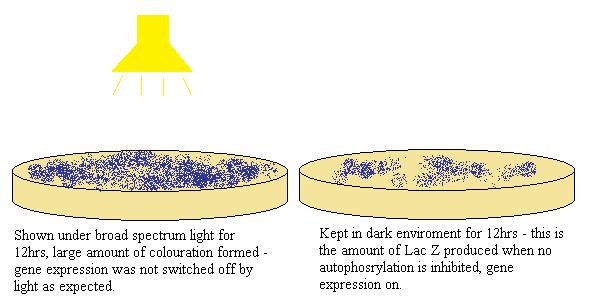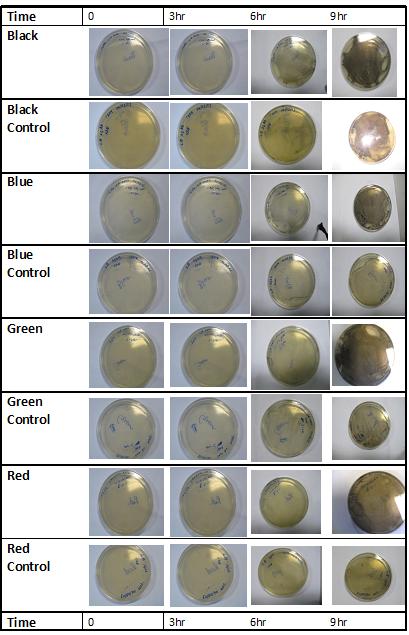Team:Sheffield/Project
From 2009.igem.org
(→Results) |
(→Project Details) |
||
| Line 59: | Line 59: | ||
| - | + | After verifying that red light inhibits the most gene expression, the characterisation of the intensity can be proceed. According to the research paper, the light intensity can effect the amount of gene expression in this system. To investigate this, 3 sample and a control strain were put into LB broth, was then exposed to red light for 12hrs at the following intensity uEins/m2/s: 2.5, 6, 7, 10. Miller Assay was then performed to measure the amount of beta-galactocidase produced at each intensity by measuring the optical density of each sample in a ooptical spectrometer. | |
== Results == | == Results == | ||
Revision as of 20:43, 13 October 2009
| Home | Team | Project | Parts | Modeling | Notebook |
|---|
|
Overall projectIn this project, we originally intended to create an E.coli system that is sensitive to multiple wavelengths of light and produce a colour indication of the specific wavelength it is exposed to. However due to limitations in the time and number of people available, and due to unexpected results the project changed significantly.
Project DetailsThe first experiment we carried to familiarise ourselves with the strain, was to repeat the light sensing ability of RU1012 as described in the Levskaya et al. paper[1], in its most simple form. Red light switch off the photoreceptor through inhibiting autophosphorylation, and therefore switching off the expression for Lac Z production. We shown borad spectrum light on one sample and kept the other in the dark so that gene expression can not be interefered. The samples were put on seperate agar plates with X-gal on it which acts as a substrate for Lac Z and producing a blue colouration. To our surprise, the result were opposite to what we expected: the illuminated plate produced more pigment than the one in the dark, whereas it should have been the opposite. No control was used in this experiment. The same experiment was repeated with a control strain to confirm that the result was systematic. Later on we realise that the wavelength that inhibits the autophosphorylation has to be a specific wavelength, a broadspectrun light that contains that wavelength does not have the same effect. Too solve that problem we have tried various measures:
The Balmer lamp provided a narrower band of wavelength, we hoped that it can characterise the E.coli system better than broad spectrum light. Experiments were repeated with Hydrogen lamp, conducted at room temperature - due to set up of the lamp, the experiment can not be carried out in an incubator at 37C. Unfortunately, this has not changed the outcome of the result, the gene expression was still not switched off.
Filter paper
ResultsAs mentioned in the section above, in the attempts to inhibit the gene expression of LacZ, we got the opposite of what was expected. Therefore we investigated and characterised the EnvZ-OmpR two component system. DiscussionFurther WorkDue to time restrictions, and the few people we had available for this project. We would to continue characterising the parts of this system, as well as repeat our the Miller assay for more values of light intensities and wavelengths. We also have the thought of new directions to develop the project after contacting Christopher A. Voigt. ReferencesPapers
|
 "
"



